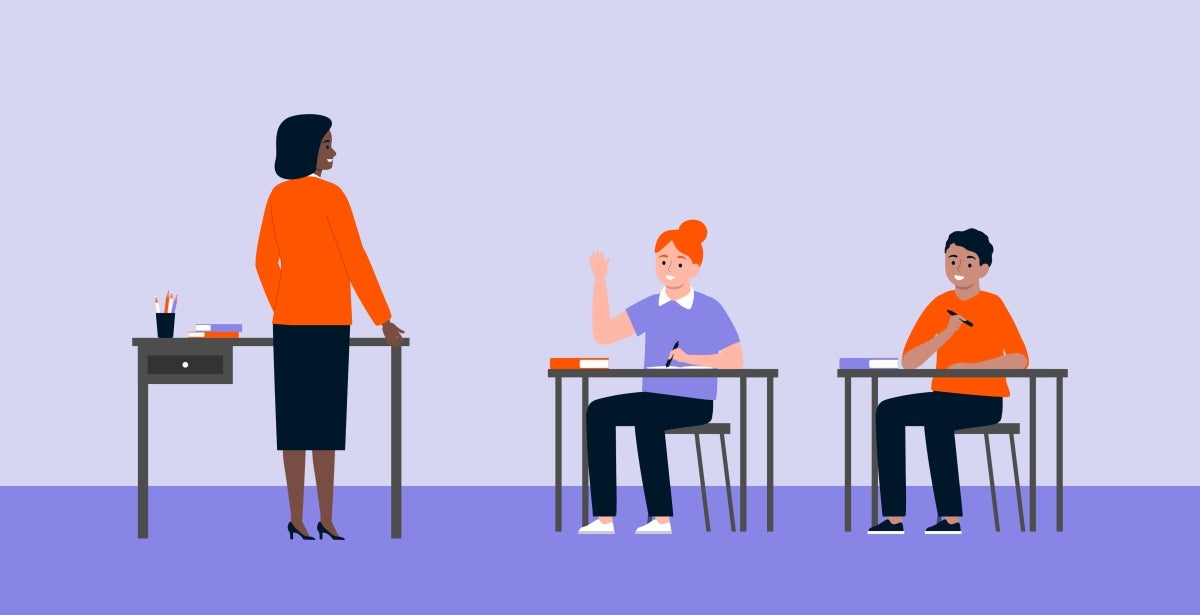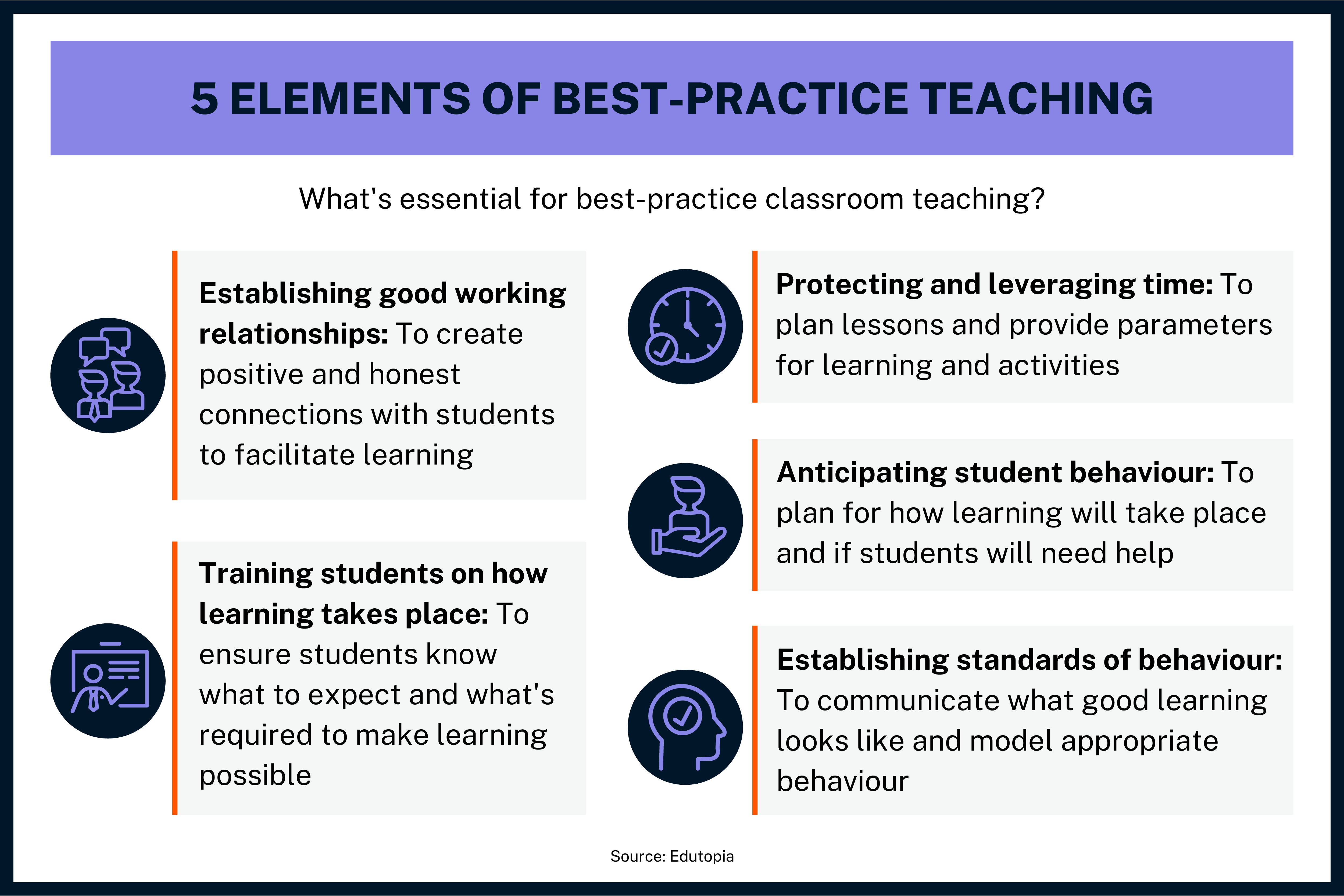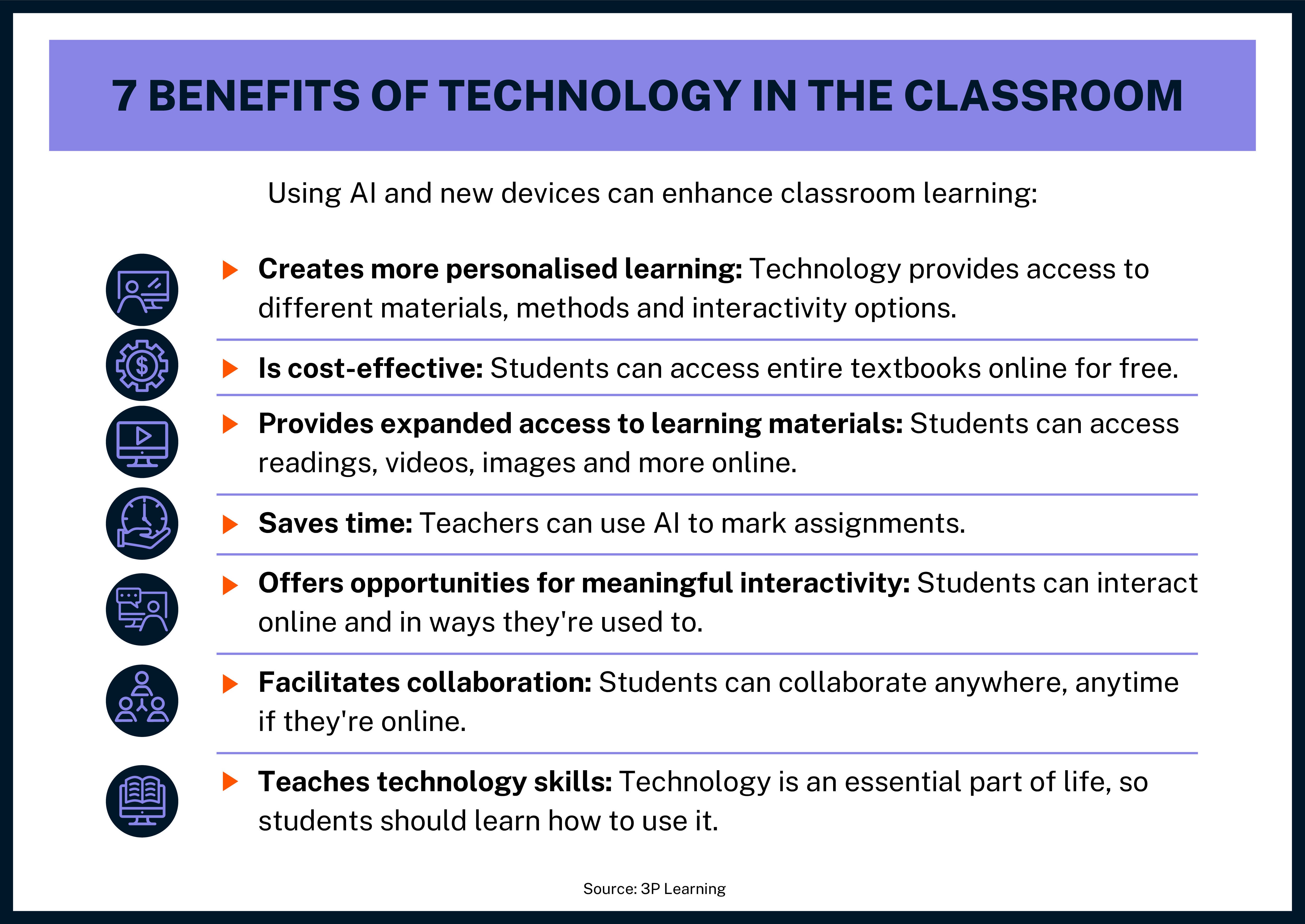
How Collaboration Between Teachers and Technology Can Improve Education
In the dynamic education landscape, technology has become an inseparable companion for today's learners. As we witness a growing preference for technology in education, students, educators and key thinkers in the education field may ask if technology could eventually replace teachers.
For centuries, teachers worldwide have offered students the life-changing gift of education. However, with teachers and technology increasingly combining forces in the modern era, the methods for providing that education are being transformed. This has led some in the field to debate whether technology on its own can replace the unique qualities that teachers bring to the learning experience, or if a human element remains necessary to effective education.
Teachers and technology
Over the past few decades, the classroom has undergone a radical transformation. In both in-person and online settings, educators have witnessed a profound evolution in the intersection of teaching and technology.
New classroom technologies
In traditional brick-and-mortar classrooms, the introduction of smart boards and other interactive display tools has allowed teachers to bring their lessons to life, fostering a more engaging and dynamic learning environment. These technological advancements have allowed educators to illustrate complex concepts through multimedia, enhancing students’ comprehension and retention of information.
The role of the teacher has shifted from being the sole disseminator of knowledge to being a facilitator who guides students through interactive and visually stimulating educational experiences.
Artificial intelligence (AI) and emerging technologies such as virtual reality (VR) and augmented reality (AR) have further expanded the possibilities within the classroom. AI-powered educational tools offer personalised learning experiences that cater to individual students’ needs and provide them with real-time feedback. VR and AR bring immersive experiences into the curriculum, allowing students to explore subjects in ways previously unimaginable.
Australian education systems have developed frameworks for the productive use of these tools and technologies. For example, generative AI has the potential to change education delivery in many ways but also poses ethical challenges and questions about academic integrity. As such, the Australian Government Department of Education has put forth the Australian Framework for Generative Artificial Intelligence (AI) in Schools, which includes six guiding principles for the effective, secure and ethical use of generative AI in education.
The changing educational landscape
The introduction of new technology has fundamentally changed the educational landscape. Virtual classrooms, videoconferencing and cloud-based collaboration tools have provided unprecedented flexibility and accessibility. Teachers can now reach students beyond their geographical boundaries and tailor their instruction to students’ diverse learning needs. However, this shift has required educators to adapt their teaching styles and master new digital tools and platforms to be able to effectively deliver content and engage with students in a virtual space.
In this tech-driven era, teachers can create a rich, technology-enabled learning experience for their students. The evolving role of educators now demands a blend of technological proficiency, adaptability and the enduring human element that can make the teaching profession both challenging and profoundly rewarding.
Does face-to-face teaching still matter?
In the age of rapid technological advancement, teachers are increasingly integrating technology into their classrooms to transform ways of learning. While technology has revolutionised education, offering a myriad of online learning platforms and interactive tools, the human connection established in traditional classrooms is difficult to replace.
The benefits of face-to-face teaching
Face-to-face teaching fosters a dynamic and interactive learning environment where educators can respond to the unique needs of each of their students in real-time. Being able to immediately provide feedback to students and gauge their engagement through nonverbal cues are crucial elements of effective teaching and learning. In-person interactions allow educators to adapt their teaching methods, address individual students’ challenges and tailor their approach to optimise all students’ comprehension. Evidence suggests that students’ comprehension is improved by being able to see other students’ body language and that of the teacher as well.
Beyond improving the transmission of knowledge, face-to-face teaching helps students cultivate essential interpersonal skills. Students learn to collaborate, communicate and engage with their peers in a physical classroom setting. Group discussions, collaborative projects and the spontaneity of face-to-face interactions contribute to students’ development of social intelligence – which is vital in navigating the complexities of the professional world.
Teachers and the classroom atmosphere
The mentorship and guidance provided by teachers extend beyond academic content. In-person instruction allows educators to offer students personalised support, encouragement and motivation, creating a sense of accountability and inspiring students to reach their full potential. Teachers serve not only as instructors but as role models, shaping the character and values of the next generation.
While technology can enhance certain aspects of education, it often lacks the nuanced, empathetic and holistic approach that face-to-face teaching provides. The physical presence of a teacher creates a learning atmosphere that goes beyond the digital realm, fostering a sense of community, inspiration and shared purpose among students.
In essence, face-to-face teaching remains a cornerstone of an effective education, offering a rich tapestry of experiences that technology alone cannot replicate. In-person interactions with teachers continue to shape students’ educational journeys and prepare them to become well-rounded citizens in an interconnected world.
5 ways to support best-practice face-to-face teaching
Teachers can build a positive and enriching learning environment by applying the following best practices to their face-to-face teaching:
1. Create a positive classroom climate
At the core of effective face-to-face teaching is establishing positive relationships with students. This involves cultivating a classroom atmosphere where trust, respect and open communication flourish.
Teachers who prioritise building strong connections with their students create a foundation for effective learning. Positive relationships enhance student-teacher interactions and foster a sense of belonging and emotional safety in the classroom, encouraging students to actively participate in their educational journey.
2. Establish learning routines to improve student engagement
Consistent routines provide students with a structured and predictable learning environment, which can help keep students engaged by reducing their anxiety and uncertainty. Classroom routines allow students to know what to expect from the teacher and what is expected from them as students, while structural and assessment routines allow them to understand how, when and why content is presented and what is required to succeed in assessment tasks.
When students know what to expect, they can focus more on learning, which can lead to increased participation and a more productive learning experience.
3. Develop technology skills to support productive learning
While face-to-face teaching traditionally emphasises interpersonal interactions, integrating technology skills into the educational process is essential in the modern era.
Teachers need to guide students in navigating digital tools, ensuring they develop the technical proficiency required in the contemporary workforce. By incorporating technology seamlessly, educators empower students to access information efficiently and enhance their overall learning experience.
4. Improve efficiencies to maximise on-task behaviours
Efficient classroom time management is crucial for maximising classroom behaviour.
Teachers must strategically organise lessons, minimise disruptions and optimise the use of instructional time to ensure that students get the most out of their learning. A well-structured and efficiently managed classroom promotes a conducive learning environment, allowing students to remain focused and actively engaged in the learning process.
5. Leverage digital tools for deeper learning
While face-to-face teaching relies on personal interactions, learning experiences can be elevated by integrating digital tools into lesson plans. By leveraging interactive platforms, multimedia resources and collaborative online tools, teachers can facilitate deeper learning experiences. These digital tools can enhance students’ comprehension, cater to students’ diverse learning styles and encourage students to explore topics in greater depth, ultimately enriching their educational journeys.
Strategically integrating digital tools ensures that technology complements rather than replaces traditional teaching methods, contributing to a more comprehensive and effective learning experience.

Infographic transcript
5 elements of best-practice teaching
What's essential for best-practice classroom teaching?
- Establishing good working relationships: To create positive and honest connections with students to facilitate learning.
- Protecting and leveraging time: To plan lessons and provide parameters for learning and activities.
- Anticipating student behaviour: To plan for how learning will take place and if students will need help.
- Training students on how learning takes place: To ensure students know what to expect and what's required to make learning possible.
- Establishing standards of behaviour: To communicate what good learning looks like and model appropriate behaviour.
Source: Edutopia
5 essential ways to support best-practice virtual teaching
In situations where students are learning completely virtually, teachers should use a strategic and compassionate approach to ensure the best outcomes for the students. Here are five essential ways to support best-practice virtual teaching:
1. Build community
In the digital realm, fostering a sense of community is paramount. Virtual classrooms lack the physical presence that naturally promotes camaraderie, making intentional efforts to build connections crucial.
Encouraging students to interact with each other through online forums, collaborative projects and virtual group activities creates a supportive community where students feel connected and engaged, enhancing their overall learning experience.
2. Foster active learning using suitable interactive tools
Virtual teaching should prioritise interactive tools that facilitate active learning.
Incorporating platforms that allow real-time collaboration, discussions and interactive activities keeps students actively involved. These tools emulate the engaging nature of face-to-face interactions, promoting participation and a deeper understanding of the material.
3. Create a media-rich learning environment with a clear learning pathway
To counter the potential detachment of virtual learning, educators must create a visually stimulating and structured learning environment.
Using multimedia resources and presentations and incorporating a clear learning pathway helps students navigate the virtual space effectively. Visual aids and multimedia elements enhance students’ comprehension and maintain their interest throughout the online sessions.
4. Divide units of study into 15- to 30-minute blocks
Given the challenges of prolonged online engagement, breaking down units of study into manageable blocks is essential. Short, focused sessions lasting 15 to 30 minutes cater to the attention spans of online learners, preventing them from experiencing cognitive fatigue and helping to ensure they can sustain their focus on the material.
5. Be “present”
Despite the physical distance, teachers must be emotionally present in the virtual space. This involves being actively engaged, responding immediately to students’ queries and providing timely feedback on their work.
Being present in virtual teaching involves cultivating a supportive and encouraging atmosphere that motivates students to actively participate and remain committed to their learning journey.
While online learning is on the rise, the human touch remains indispensable. Teachers must infuse care and passion into their virtual teaching methods while recognising that providing emotional support is as vital as delivering content in keeping students engaged and motivated in the virtual realm.
How teachers and technology can work together
Technology use can mark an inevitable and transformative evolution in education. With technology omnipresent in society, its integration into classrooms is not just advantageous but essential in preparing students for future technological innovation. However, the success of this integration hinges on the positive and strategic partnership between teachers and technology.
Teachers serve as orchestrators, guiding students through the vast digital landscape. By leveraging technology, educators can personalise students’ learning experiences, catering to students’ varied needs. Interactive whiteboards, educational apps and online resources become powerful tools in the hands of adept teachers, enhancing the overall quality of their instruction.
Moreover, technology serves as an amplifier of effective teaching methodologies. It can streamline administrative tasks, provide real-time feedback and facilitate collaborative learning experiences. The use of digital tools allows teachers to tailor their approach to individual students’ strengths and weaknesses, fostering a more inclusive and engaging learning environment.
The inevitability of technology being used in classrooms underscores the importance of each teacher’s role in deciding how it’s used. As facilitators of knowledge and mentors in the digital age, educators play a pivotal role in ensuring that technology augments, rather than replaces, the human touch in education. Teachers nursing technology can propel education into an era of unprecedented possibilities and enrich the learning experiences of all students.
7 benefits of using technology in the classroom
Technology has fundamentally and irrevocably changed the educational landscape and learning experience for teachers and students alike.
Here are seven benefits of teachers and technology working together in the classroom:
1. Engaged and personalised learning
Technology has revolutionised education by offering more engaging and personalised learning experiences. AI-driven platforms and interactive applications adapt to individual learning styles, tailoring content to students’ needs. This personalisation caters to students’ learning preferences and can enhance their comprehension and retention.
2. Cost-effectiveness
Integrating technology into education can be cost-effective in the long run. Digital resources, online platforms and virtual classrooms eliminate the need for traditional materials and reduce printing costs. Additionally, technology enables remote learning, potentially saving on infrastructure expenses.
3. Expanded access to learning materials
One of the remarkable benefits of technology in education is the access it provides to an ever-expanding array of learning materials. Online repositories, e-books and educational apps provide students with unrestricted access to information, fostering self-directed and lifelong learning.
4. Time-savings for teachers
Automation and AI-driven tools can alleviate the administrative burden on teachers, allowing them to focus more on teaching. Grading, attendance tracking and lesson planning can be streamlined, enabling educators to invest their time in creating more engaging and impactful learning experiences.
5. Facilitation of meaningful interactivity
Technology facilitates meaningful interactivity between students and teachers. Virtual classrooms, collaborative platforms and interactive simulations create an environment where students actively participate, fostering a deeper understanding of the subject matter.
6. Enhanced collaboration
Digital tools promote collaboration among students and educators, transcending geographical boundaries. Collaborative projects, online discussions and shared documents encourage teamwork and expose students to diverse perspectives.
7. Expanded technology literacy
The integration of technology into education allows students to gain crucial skills and expand their digital literacy. Students learn to navigate and critically evaluate digital information, preparing them for a technology-driven future.
How technology in teaching can go wrong
While technology offers numerous benefits to educators and students, its implementation can go awry if it’s not carefully managed. One significant challenge is the potential for an overreliance on technology when educators substitute automated processes for meaningful interactions with students. Excessive use of technology may lead to teachers losing their personal connections with their students, hindering the students’ development of essential social and communication skills.
Moreover, the digital divide poses a serious risk, with unequal access to technology exacerbating educational inequalities. Students without reliable internet access or adequate devices may find themselves at a disadvantage, which can create disparities in learning opportunities. Additionally, issues such as technical glitches, cyber threats or data privacy concerns can disrupt students’ learning environment, causing them to feel frustrated and distracted.
The ineffective integration of technology may also result in a superficial understanding of concepts, as students may focus more on navigating digital tools than grasping the underlying content. Therefore, a cautious and thoughtful approach is crucial to ensure that technology enhances, rather than hinders, students’ educational experiences.
7 disadvantages of technology in the classroom
While teachers and technology can work well together, technology in the classroom presents challenges that educators must navigate. These include the following:
1. Distractions and disruptions
One of the primary drawbacks of using technology in education is its potential to distract students. Students may easily become sidetracked during lessons, diminishing their focus on the learning material.
The constant allure of social media, even when students are meant to be using their devices for learning, can disrupt the educational environment and hinder students’ overall learning experiences.
2. Bias in AI, including in assessments
The use of artificial intelligence in education is not without its challenges. AI algorithms may inadvertently perpetuate biases, leading to unequal treatment in assessments and evaluations. If not carefully designed and monitored, these biases can contribute to unfair grading and reinforce existing educational inequity.
3. Access to misinformation
The vast expanse of information available on the internet brings with it the risk of students being exposed to misinformation. Students, while conducting research or learning independently online, may encounter inaccurate or unreliable information, potentially leading them to have misconceptions and a compromised understanding of the subject matter.
4. Steep learning curve
Integrating technology into the classroom requires a learning curve for both students and teachers. The rapid evolution of technology necessitates that teachers pursue ongoing professional development to stay abreast of the latest tools and methodologies.
The time and resources required for such training can strain educational institutions and impact the quality of teaching.
5. Isolation
Despite the connectivity afforded by technology, its overuse can contribute to students’ social isolation. Excessive screen time and reduced face-to-face interactions may hinder students’ development of essential interpersonal skills, potentially affecting their social and emotional well-being.
6. Technology-induced tension
The introduction of technology into the classroom can sometimes lead to tension, particularly when technical issues arise. Malfunctions, software glitches or connectivity problems can disrupt lessons, creating frustration for both students and teachers.
7. Limited technical support
Inadequate technical support can amplify the challenges associated with technology in education. Schools and educators may face difficulties in addressing technical issues promptly, leading to disruptions in the learning process and exacerbating the frustrations of both students and teachers.
Schools need to establish robust technical support systems to mitigate these challenges.

Infographic transcript
7 benefits of technology in the classroom
Using Al and new devices can enhance classroom learning:
- Creates more personalised learning: Technology provides access to different materials, methods and interactivity options.
- Is cost-effective: Students can access entire textbooks online for free.
- Provides expanded access to learning materials: Students can access readings, videos, images and more online.
- Saves time: Teachers can use Al to mark assignments.
- Offers opportunities for meaningful interactivity: Students can interact online and in ways they're used to.
- Facilitates collaboration: Students can collaborate anywhere, anytime if they're online.
- Teaches technology skills: Technology is an essential part of life, so students should learn how to use it.
Source: 3P Learning
Why technology cannot replace teachers
While technology plays a crucial role in education, it cannot fully replace the multidimensional and dynamic role of teachers. Human educators bring empathy, adaptability and personalised understanding to the learning environment, elements that technology can’t replicate. Effective teaching involves more than the transmission of information; it requires inspiration, motivation and the ability to address students’ individual needs.
While technology can support best-practice teaching methods, it falls short in providing the holistic, interpersonal connections that are essential to a comprehensive education. And, importantly, not all students or teachers may benefit equally from technology, emphasising the importance of a balanced approach in which technology enhances, but does not entirely substitute for, the invaluable contributions of skilled educators.
Accelerate your career with ECU's Master of Education course
Edith Cowan University Online offers an accelerated Master of Education course designed to fit the demanding schedules of busy professionals. This 100% online degree provides the flexibility to balance full-time work while advancing your education.
At ECU Online, you will learn from industry experts at one of Australia's leading universities. The course allows you to choose your specialisation, enabling you to tailor your education to meet your career goals.
Secure your future in education with ECU’s accelerated Master of Education today.
Speak to one of our Student Enrolment Advisors on 1300 707 760 or email future.student@studyonline.ecu.edu.au to request a course brochure.



